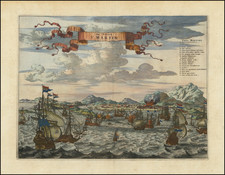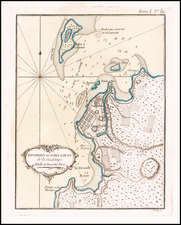Guadalupe During The Early Period of French Colonization
Rare early map of the Island of Guadalupe, published in Paris by Pierre Mariette.
The map reflect the French interest in what was then a Spanish possession. The map was issued only 15 years after the French colonization of the island by the Compagnie des Îles de l'Amérique in 1635. The map includes portions of Isle de la Desirade and Mariegalante Isle.
The first attempt to colonize the island was made in the 16th century by the Spanish, but were rebuffed by the indigenous people, who were resistant to being colonized and converted to Christianity. In 1626, the French under Pierre Belain d'Esnambuc began to take an interest in Guadeloupe, expelling Spanish settlers. At the time, the island was inhabited by the Carib and Arawak indigenous peoples, who had lived on the island for centuries. The Spanish arrived with the goal of establishing a colony and converting the indigenous people to Christianity.
In 1635, under the direction of Charles Liénard de L'Olive and Jean du Plessis d'Ossonville, the island of Guadalupe claimed by the Compagnie des Îles de l'Amérique, a French company that had been granted a royal charter by King Louis XIII to colonize and settle the islands in the Caribbean. The French saw the island of Guadalupe as a valuable strategic location, due to its close proximity to the Spanish colonies in Central and South America.
By 1640, the Compagnie des Îles de l'Amérique had gone bankrupt. Guadeloupe was sold to Charles Houël du Petit Pré, who began plantation agriculture, with the first African slaves arriving in 1650. Slave resistance was immediately widespread, with an open uprising in 1656 and mass desertions that lasted at least two years until the French compelled indigenous peoples to stop assisting them.
Ownership of the island passed to the French West India Company before it was annexed to France in 1674. Institutionalized slavery, enforced by the Code Noir from 1685, led to a booming sugar plantation economy.










![Cuba Insula [with] Hispaniola Insula [with] Ins. Jamaica [with] Ins. S. Ioannis [with] I.S. Margareta [with] Havana portus](https://storage.googleapis.com/raremaps/img/small/95302.jpg)
![[St. Kitts / St. Christopher] Carta De La Isla De San Christoval Reducida y Gravada, Por D. Juan Lopez . . . 1780](https://storage.googleapis.com/raremaps/img/small/84337.jpg)
![Martinico [and] Dominica](https://storage.googleapis.com/raremaps/img/small/85250.jpg)
![[St. Barths / St. Martin / Anguilla / Antilles ] -- Plans of Ports Surveyed by Captain Edward Barnett R.N. 1846](https://storage.googleapis.com/raremaps/img/small/70950.jpg)
